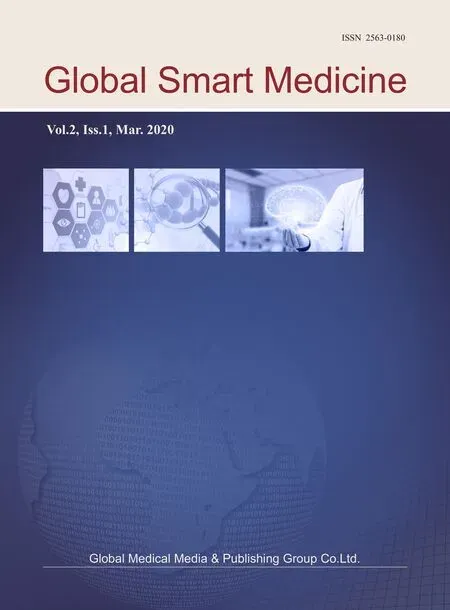Application based on integration platform and big data center
Yang Jun, Yang Guo-qiang
Department of Information, Suining Central Hospital, Suining 629000, Sichuan Province, China
Abstract With the development of the national economy and the continuous advancement of hospital informatization, clinical information systems represented by electronic medical records and PACS system have been widely used. In the process of promoting informatization in hospitals, the architecture of hospital application systems is improving, however, the problems regarding data integration and utilization become increasingly prominent. The application of integration platform contributes to an interconnection and interworking among various business systems as per the national data standards. Meanwhile, the hospital health big data center is established and applied to many fields such as clinical, scientific research and decision analysis. By means of informatization approach, the construction of “smart hospitals” is feasible and promoted.
Key words: integration platform; data center; big data; Hadoop
Analysis on Application Architecture of Hospital Information System
It mainly includes a management information system to provide basic management services, a clinical information system and medical technology support system to provide medical information management, a hospital operation management system to provide financial accounting, cost accounting and budget management, a decision support system to provide medical statistical analysis and operation evaluation, and a regional collaborative medical system to provide collaborative services and sharing among medical institutions.
Hospital management information system
It is consisted of generally applied modules, such as management subsystems (outpatient registration,outpatient charging, triage, ADT management, medical technology billing, hospitalization charging, infusion room management, medical order charging and so on)and deepened logistics management system (pharmacies,drug warehouses, dispensing center, equipment, materials,medical precious consumables, supply room, blood bank). The extended auxiliary management part mainly includes appointment center, scientific research and teaching, hospital infection, OA and patient relationship management, etc. In addition to individual business characteristics of each subsystem, certain business logic relationships are linked between subsystems. The accuracy and integrity of the system data will directly affect the application quality of clinical information systems,business management systems, and decision support systems.
Clinical information system
The collection, storage, processing and transmission systems regarding patient’s medical information aimed at improving medical quality and medical work efficiency may provide direct services for medical work. The system mainly comprises two parts. One is a clinical information system that directly serves medical staff in clinical departments, such as outpatient physician workstation,resident physician workstation, nursing information system, mobile medical workstation, nursing department management system, clinical pathway management and so on. The other is a clinical support information system for auxiliary diagnosis services, such as LIS system,PACS system, monitoring system, pathology, endoscopy,radiotherapy, medical knowledge consultation (medicine consultation, etc.), nutritional diet and other systems.These clinical information systems are the components for the establishment of a complete electronic medical record and are constructed centering the application of electronic medical records. Through the electronic medical record system, different clinical information at different periods are integrated according to the classification and sequence of events centered on the patients, and are subjected to a structured storage in the unified standard (CDA) manner.
Hospital operation management information system
In view of the hospital operation management needs, with the goal of achieving the optimal social and economic benefits, a series of economic business activities in the process of medical operation are integrated to a comprehensive management system. It covers cost accounting (department cost accounting, project cost accounting, disease entity cost accounting), performance appraisal, budget and control, business accounting,salary management, bonus distribution and so on. The system will establish a multi-level management network,which is characterized by horizontal association and vertical connection, oriented by the budget management,centered on the accounting, based on the cost accounting,targeted at the hospital operation decision, guaranteed by the performance appraisal and embodied by salary management, accordingly a comprehensive operation management platform that highly integrates the hospital’s human flow, financial flow, material flow and information flow is constructed.
Hospital decision support system
It is the terminal processed by Hospital Information Systemhospital information system and acts to process the decision-making information in hospital information system covering the medical, teaching, research, and human resource, financial, material analysis related to hospital management, and to provide management decision-making basis for managers at all levels. It mainly comprises two parts, one is the operation decision support, and the other is medical decision support.The data in this system mainly derive from HIS system and clinical information system. Due to a huge amount of basic business data, data warehouse technology is used to extract, transform and load data, and gradually realize multi-dimensional analysis, dynamic analysis and pre-defined report-based applications, and the index system analysis applicable for individual hospitals is also supported.
Regional collaborative medical information system
It can integrate medical institutions and community health service centers at all levels within certain jurisdiction to form a harmonious organization, realize information sharing and medical cooperation between various institutions, and it is the horizontal connection of the hospital information system and the vertical extension towards community medical services. Relevant information can be uploaded to the regional medical information center through the collaborative medical service system.
Problems Faced by Hospital Data Sharing
In response to the rapid development of hospitals, various professional application systems have been developed in various departments within the hospitals, to support the construction and development of disciplines, thus emerging data islands. We analyzed the data volume and transmission frequency in some hospital business information systems, detailed as follows.
(1)Data exchange analysis within the hospital:
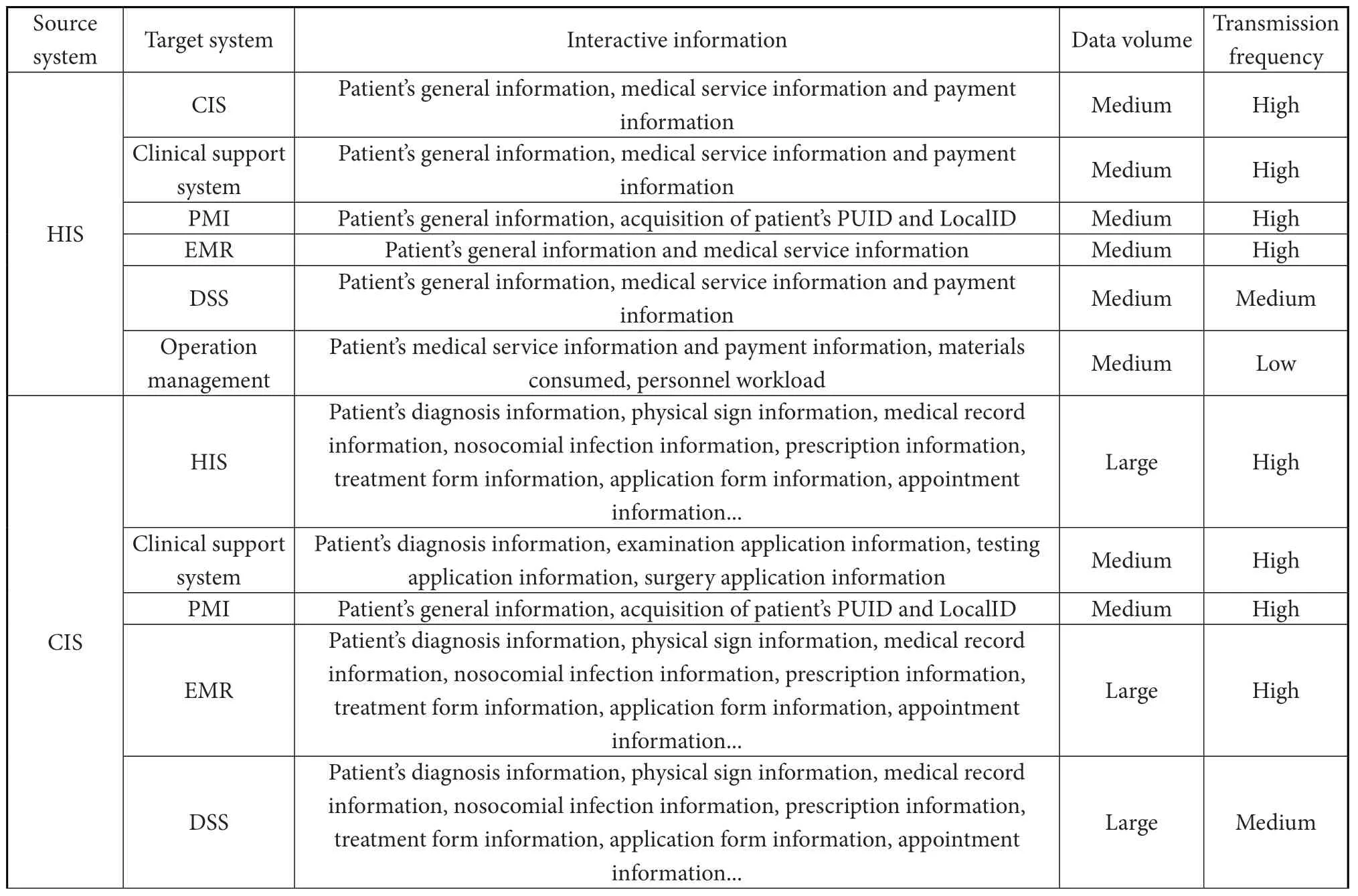

(2) Data exchange analysis outside the hospital:

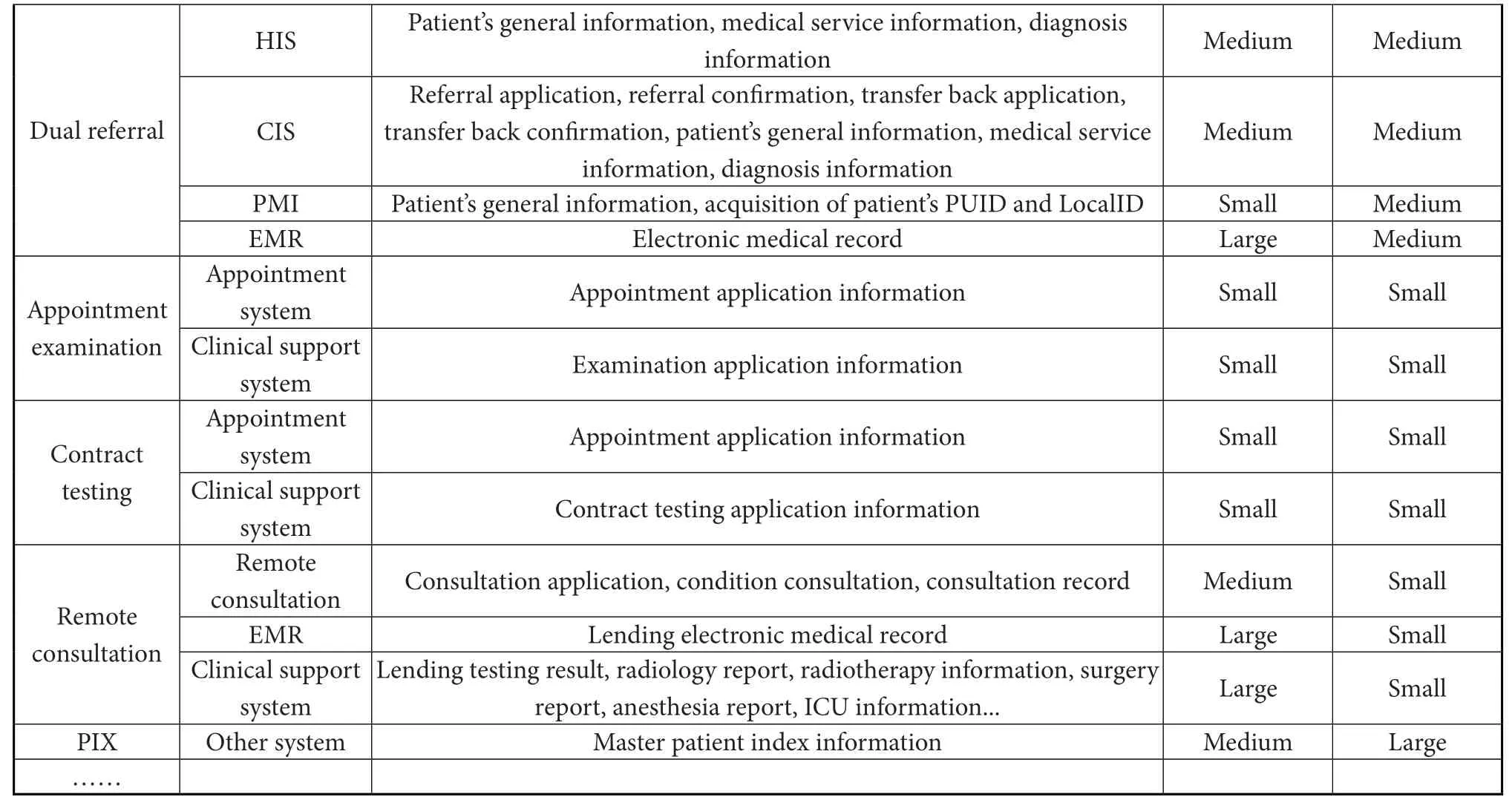
Exploration of Novel Application Architecture of Hospital Big Data
Business system data standardization
Each subsystem in the hospital information system focuses on different fields and has a good application depth and coverage. However, it remains unclear that whether the data set of these subsystems conforms to 224 national health information standards issued by the government,whether their functions conform to the requirements of “National Hospital Information Construction Standards and Specifications (Trial)” jointly issued by the Planning and Information Division and the Statistical Information Center of the National Health Commission,PRC in April 2018. Therefore, the data standardization is considered the top priority of improving the level and application capabilities of hospital information systems. The data standards of the hospital data center adopted are based on a combination of HL7V3, HL7V2,CDAR2, interconnection and interworking specifications stipulated by the National Health Commission, PRC.The standardized process message is subjected to HL7 international standard, the resultant documents such as examination report and testing report are subjected to CDA standards, the operation and anesthesia data are subjected to the interconnection and interworking specifications stipulated by the National Health Commission, PRC, and customizing standards are recommended for data for which no applicable standards are followed.
Construction of medical integration platform
The integrated software system can well solve the collaborative application and interconnection among medical business systems in the hospitals. While an integration platform support is required for the business outside the hospitals; for heterogeneous information systems that handle both in-hospital and out-of-hospital business, a medical integration platform support is needed. Therefore, for the construction of a modern smart hospital, medical integration platforms are indispensable,and they must have strong integration capabilities with heterogeneous systems. The establishment of a flexible, highly integrated, and scalable medical integration platform can effectively solve the problems of interconnection and data standardization, and realize the multiple-level integration in terms of data,applications, processes, services, and interfaces through the transmission and sharing of medical information mediated by EAI. This platform can lay a solid foundation for the construction of health care big data center[1].
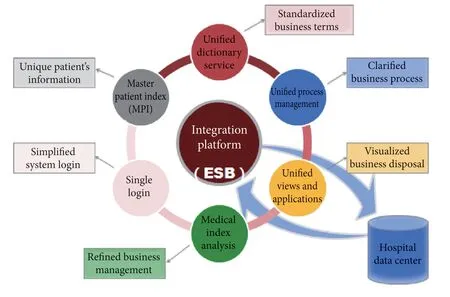
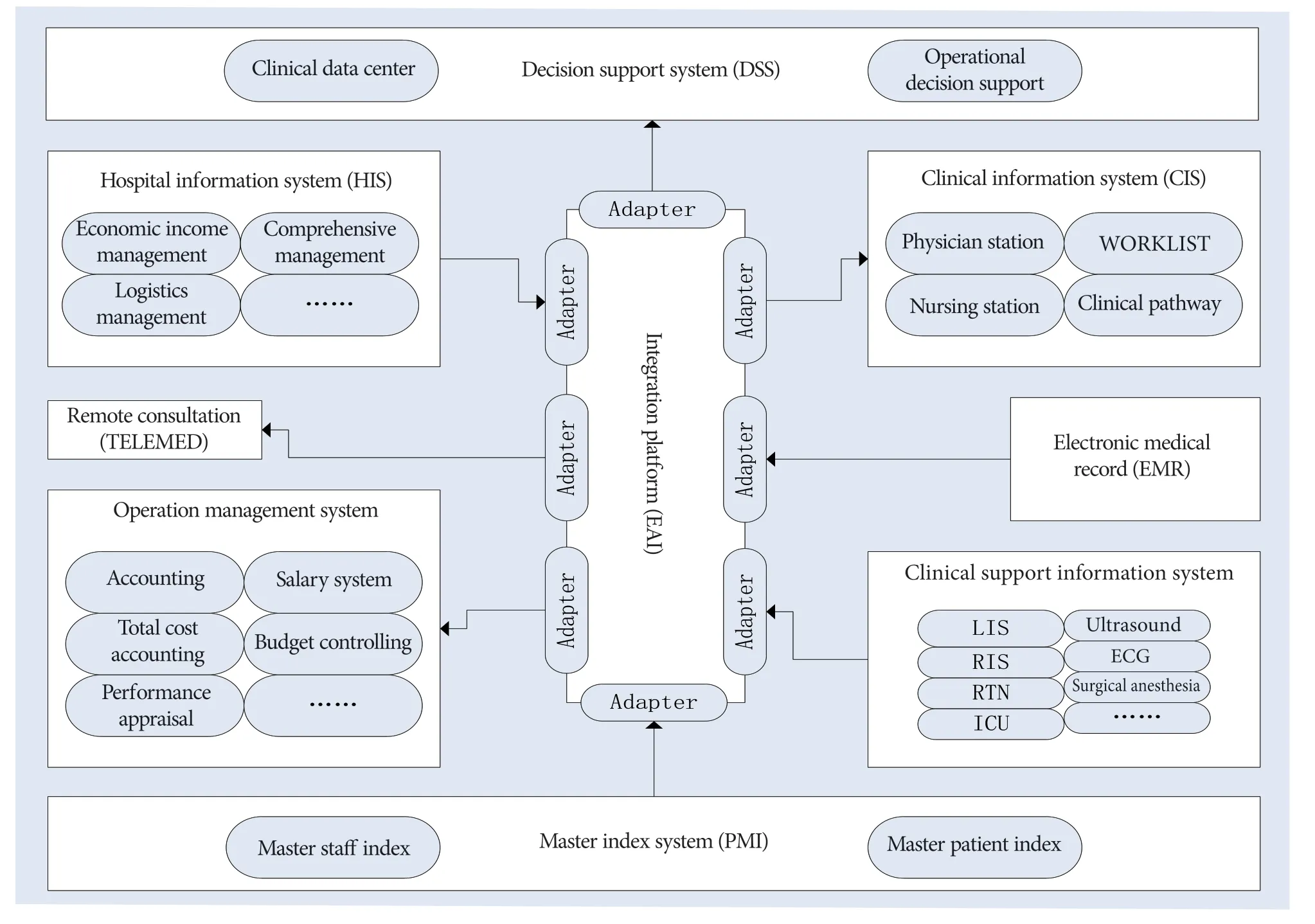
The integration platform needs to combine service bus integration technology with SOA technology. First, the service bus is service-oriented and the service is based on standards, accordingly the service bus has the capability of shielding the differences of heterogeneous system platforms. The service bus also supports business process processing. These processes are some simple routing rules or the re-arranged services performed by a powerful process engine. The scope of the processes is logically either within a medical institution or between multiple medical institutions. The service bus also supports data transformation and can shield the same semantic data differences between heterogeneous systems. The service bus is the premise for the integration of various application systems[2]. The intra-hospital system integration architecture is described as follows:Following the SOA concept and realizing the integration platform products embodied by the service bus technology,it integrates service registration, node management, data transformation, information routing, workflow engine,security control, permission management and other technologies. It adopts a “bus” topology structure, which provides a solid foundation for the loosely-coupled,service-oriented architecture between medical institutions.The integration platform has the service-oriented, eventdriven and message-oriented characteristics. It is a data exchange and information sharing platform based on a service bus. Through the adapters entering each business system, it realizes the encapsulation of application interfaces, reliable and safe service registration, and service invocation. Additionally, it completes the looselycoupled interconnection between business systems. The inter-hospital system integration architecture is described as follows:
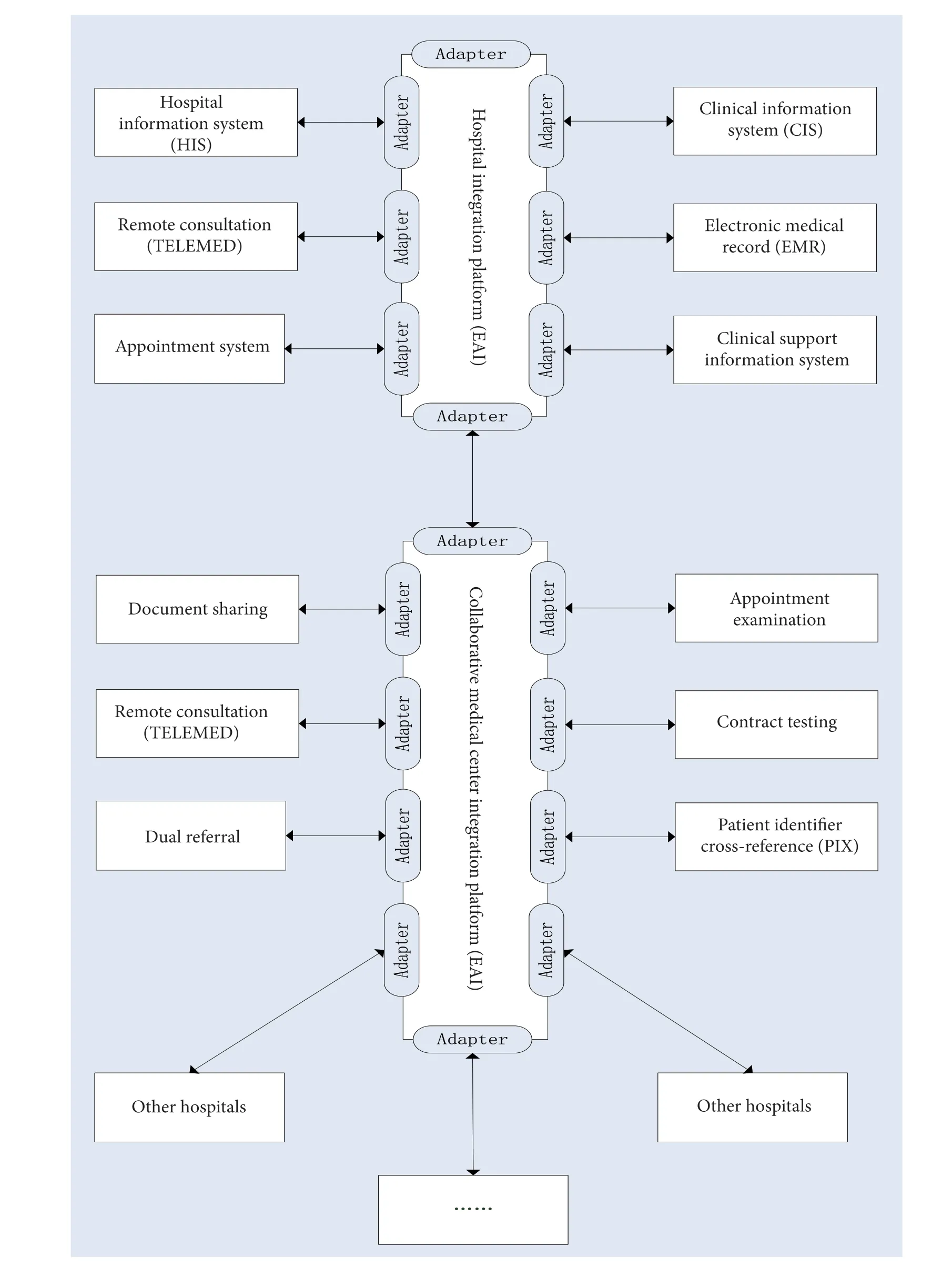
The integration platform can realize the integration of various business systems in hospitals, connect with domestic mainstream medical IT systems via standard adapter components, and achieve data exchange and business process optimization. It also provides a unified data management platform for the hospitals and achieves advanced management functions above the data interface.
Construction of health care big data center
At present, many hospitals have established basic application software with a wide coverage, including HIS,CIS, EMR, clinical pathway, LIS, PACS, surgical anesthesia,intensive care and other application systems that support all aspects of the hospital’s business, and the software can meet the daily business requirements in hospitals. Data center construction mainly involves the following aspects:
Construction of hospital data center (HDR): through the integrated platform, business data are collected, a complete and traceable hospital clinical data center is established to meet the flexible data application requirements. Based on the hospital data center, a subject-based comprehensive application database is formed to provide more unified,complete and efficient clinical data source for users at all levels of the hospital. Meanwhile, it offers strong data support for the hospital refined management. Accordingly more effective medical management is achieved and the quality of medical services is improved. At the same time, a platform concerning the medical information consultation, retrieval, presentation and medical decision support, and involving medical personnel, various medical instruments and various application software is available for end users. The purpose is to comprehensively improve the quality of medical services, provide a platform for medical academic exchanges, and give strong data support services for various systems involving clinical business[3].
Data-centered framework: a Hadoop-based hospital medical information ecosystem is built to integrate a large number of tools and components, which can meet different computing, storage and analysis needs. Users are allowed to easily develop and run the applications of data processing on Hadoop. It is advantageous due to high reliability, high scalability, high efficiency and high fault tolerance[4].
Historical data migration:the hospitals have accumulated decades of historical data, and several systems may have undergone the replacement of different system suppliers.These historical data are the wealth of the hospitals, and shall be collected, cleaned and archived step by step.

Real-time data access: After the historical data are collected, real-time data generated by the hospitals shall be docked to the data center and connect with historical data,so as to ensure data consistency and establish a complete health care center for hospitals.
Application Based on Big Data Center
Unified view for patients
The unified view for patients system adopts two forms:“medical treatment view” and “categorized view”. This is an integrated data presentation application based on data center data. The B/S architecture-based design allows an embedding in any business system, such as physician station, medical technology system, surgery and anesthesia system and so on. It is convenient for physicians to completely understand the patient’s past medical history, which greatly improves the efficiency of clinicians’ diagnosis and treatment. At the same time,it supports the patient matching function, the patient uniqueness matching function based on the master patient index, the medical treatment information integration function based on the master patient index, the function of displaying the visit sequence according to the patient’s visit type and time, and the function of collecting patient’s data according to the visit sequence.
Operational decision analysis
Using the advanced business intelligence data analysis technology, data analysis can be performed from the aspects of “daily operation, treatment quality and safety,work efficiency, workload, patient’s burden and resource allocation”, so as to better realize the operation monitoring and analysis in the whole hospital, the primary analysis on medical quality and safety, the work efficiency analysis,average hospital stay, bed conversion frequency and other monitoring analysis.
Research data query
The scientific research data query system, based on the data center, allows a query for all hospital data. Through flexible full-text retrieval, patient retrieval and free query functions, it provides clinicians or scientific research physicians with data query tools, to perform case review or scientific research analysis. Full-text retrieval tools is applicable for keyword query of unstructured text, free query tool is applicable for structured data derived from multiple sources through free conditional combination query, and patient retrieval tool is applicable for prospective research or known patient information, which requires a comprehensive viewing of patient’s information and feature aggregation scenario.
Unified data reporting
As the medical reform is deepening and the foundation of medical informatization is improving in recent years, competent authorities have gradually promoted data reporting and data sharing, thus increasing the requirements for the data scope, data granularity, data details and data quality to be reported. Data reporting and sharing platforms rely on the hospital data center. The required data are extracted from the data center, followed by transforming data standardization, checking and verifying the reported data, reporting the related security and permission configuration. Finally, after the relevant business departments summarize and supplement the data to be reported, the data reporting is performed via the reporting adapters to connect with the front-end processor of the National Health Commission, PRC, thus forming a hospital data sharing and reporting platform.
- Global Smart Medicine的其它文章
- Design and implementation of Internet application security protection
- Design of a dynamic health record management system of chronic patients based on regional medical consortium
- Discussion on Internet of Things communication technology and its general development trend
- Practical exploration of artificial intelligence in the field of medical nursing care
- Instructions for Authors Journal of Global Smart Medicine
- Research and application of information extraction technology in clinical medical records

